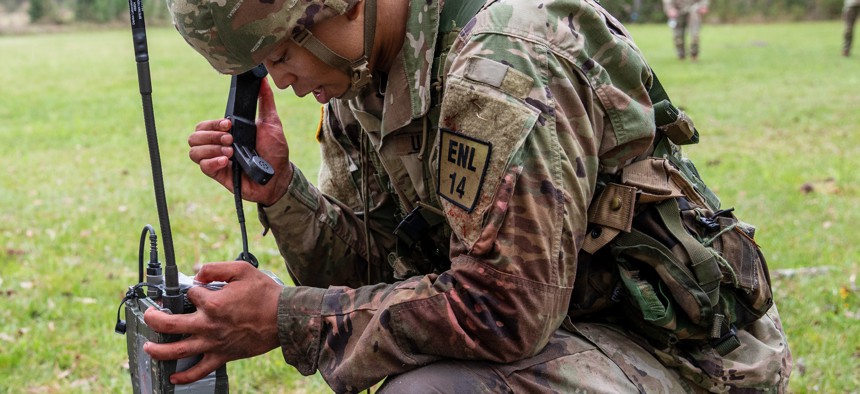
Army communications would get a boost in the 2023 omnibus spending bill. Here, a soldier makes a medical evacuation radio call during the Georgia National Guard Best Warrior Competition at Fort Stewart, Ga., March 22, 2022. U.S. Army / Sgt. 1st Class R.J. Lannom Jr.
More Money For Info Ops, Army Recruiting, Cyber In Omnibus
Bill would also boost defense research funding once again.
Defense research and development spending would rise again in 2023 if the House approves the omnibus spending bill passed by the Senate on Thursday. The bill contains $136.7 billion for research, development, test, and evaluation funding, nearly $10 billion more than the Biden administration asked and $20.5 billion up from last year.
A quick look at defense tech investments for existing programs shows continued support for autonomous technologies across a myriad of platforms, money for cybersecurity, missions, and forces, and more funds for research and development.
Here are some other things that stood out:
- Information operations would get $238.8 million for military information support operations, which is nearly $40 million more than requested. Most of that boost goes toward the info ops program at INDOPACOM.
- Army recruiting and advertising would get $791 million, $100 above its request.
- The Army would get $314 million for commercial-ready communications technologies, and got several program increases for high-frequency radios, and software and services for Joint All Domain Command and Control.
- The Air Force was dinged around $5 million for being “early to need” on some of its JADC2 procurements for strategic command and control.
- The Air Force’s cyberspace sustainment appropriations saw program increases in weapon system sustainment ($40 million) and cyber operations for base resilient architecture ($10 million). Relatedly, the Defense Counterintelligence and Security Agency got $15 million more than requested for its joint cyber intelligence tool suite.
- The Air Force also got $15 million for squadron-level 3D-print capabilities. There was no listed amount for this in the budget request, according to the bill.
- Satellites are a major priority for the Space Force with $442 million committed to buying protected wideband satellites that will “provide resilient, jam resistant tactical communications to support warfighter needs.” Lawmakers want the Air Force secretary to deliver a funding plan for launch and operations.
- Navy got $477.5 million for cyberspace activities in operations funds and a $19 million increase to the Pacific Multi-Domain Training and Experimentation Capability, a virtual training environment, under Combatant commanders direct mission support (a total $344.7 million).
- The Navy also got more money to buy commercial off the shelf tech for supply chain risk management tools–a $12 million program increase out of an $810 million acquisition, logistics, and oversight budget.
- The Office of the Secretary of Defense also got $2.4 billion in operations funding, which included a $50 million program increase to improve access to digital talent.
- Operations funding for the Defense Department’s acquisition workforce development account nearly doubled from the requested amount, totalling $111.8 million. This includes a $3 million boost for diversity in STEM talent development under hiring and recruiting.
- Congress wants the defense secretary and military chiefs to assess costs and propose potential locations for “establishing a Joint All Domain Training Center in the eastern half of the United States.”
Unanswered questions on innovation
The nearly $2 trillion government spending bill is expected to pass both chambers before the holidays amid looming concerns of prolonged stopgap funding, which can inhibit starting new efforts. However, appropriations seem to align with the Defense Department’s plans to buy and develop more innovative technologies as it prepares for potential conflict with China.
But Congress still had some questions, particularly with how the military services collaborate on innovation efforts via the Rapid Defense Experimentation Reserve Fund, or RDER.
The reserve was set up last year with $34 million for fiscal year 2022 as a way to quickly come up with the best prototypes across the services, combatant commands, and commercial companies.
The Pentagon requested $358 million for RDER in 2023, according to the bill. But lawmakers worry about the program’s “ability to synchronize experimentation” and align with program acquisition timelines. The agreement mandates the defense undersecretary for research and engineering and service secretaries to submit a report with a schedule and plan for RDER activities.




